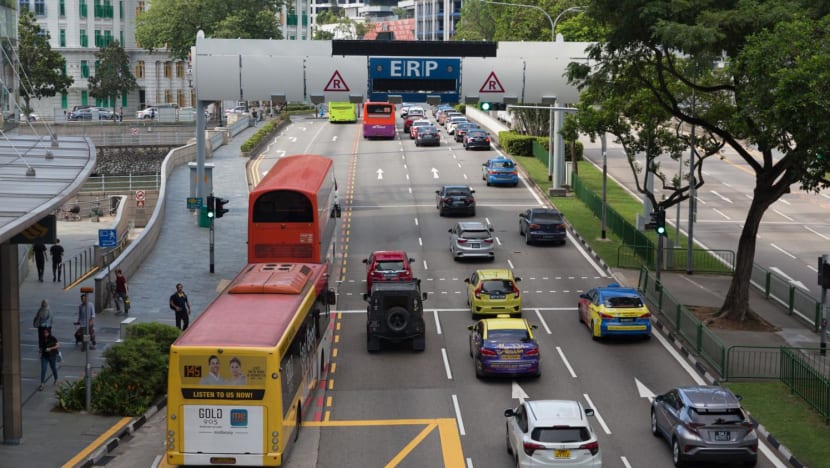More cars, higher congestion charges: Experts on what it would be like if COE was replaced with ERP 2.0
With COE prices hitting new highs and new ERP units set to be installed this year, CNA asks experts to imagine a transport system that targets usage rather than ownership.

An Electronic Road Pricing (ERP) gantry in Singapore. (File photo: iStock)
SINGAPORE: Could the next generation of Singapore's Electronic Road Pricing system – with new in-vehicle units set to be installed starting this year – someday replace the Certificate of Entitlement scheme?
Soaring prices of Certificates of Entitlement (COEs), which again set a new record last week, have raised questions about whether the system needs an overhaul.
The new Electronic Road Pricing system, known as ERP 2.0, will be satellite-based and can detect whether a car is in a congested area.
It will also be capable of charging drivers based on the distance travelled or vehicle usage, then Transport Minister Ong Ye Kung said in 2020.
But he said the government was “holding back” on shifting to distance-based charging, noting that such a policy has many implications and should be studied carefully.

COE controls car ownership in Singapore, while ERP aims to limit congestion by charging a fee to those who drive to high-traffic areas during peak hours.
If road users were charged for the distance travelled under ERP 2.0, could that be a viable alternative to COE? How would such a system work? CNA asked the experts.
LIFE WITHOUT COE
ERP 2.0 can technically replace car ownership restrictions in Singapore, but there will be knock-on effects on parking and congestion, experts said.
First off, congestion would be much worse, said Associate Professor Raymond Ong of the National University of Singapore (NUS). This is especially as ERP prices may not increase much initially due to resistance from the public.
Associate Professor Walter Theseira, who teaches economics at the Singapore University of Social Sciences (SUSS), said other costs associated with driving would rise if buyers no longer need to get a COE.
“Such a system would likely require much more extensive ERP charges throughout Singapore, as well as substantially higher charges to control congestion,” he said, pointing to London’s congestion charge of £15 (S$25) a day.
By comparison, the most expensive ERP charge at a single gantry in Singapore is S$6.
In theory, the new ERP system means the authorities can dynamically change the price being charged and where the virtual “gantries” are, said Dr Terence Fan, an assistant professor of strategy and entrepreneurship at Singapore Management University.
A virtual gantry could be set up overnight just by changing something in the system, he said. “When we go through that particular point, even though there’s nothing there, automatically the drivers will be charged.”
He gave the example of traffic jams along Orchard Road during the year-end season when Christmas lights are on display.
“They can dynamically adjust the gantry and say well, they’re going to start by charging S$40 to enter, or even S$100 to deter people from going into it,” said Asst Prof Fan. But he added that road users would want advance notice of such changes.
LACK OF PARKING FACILITIES
Another problem is the lack of parking space if Singapore's car population increases in response to the removal of the COE system, said Assoc Prof Theseira.
Some Housing and Development Board (HDB) flats and private residential estates are “already straining at the seams with insufficient car park provision”, he said.
“It’s likely that implicit controls on vehicle ownership would simply shift to parking controls instead.”
Related:
Car park spaces in Hong Kong, for example, are extremely pricey, he said. In Japan too, car owners may not be allowed to register their vehicles without proof of a parking space.
“I don't expect that to occur everywhere in Singapore, but the point is that the overall cost of car ownership may not be much lower under a no-COE policy,” said Assoc Prof Theseira. “It may simply be shifted instead to ERP pricing, as well as to car park charges and allotments.”
Asst Prof Fan of SMU said people would complain whether it is expensive COEs or high ERP charges. But the COE system is unfair in that anyone, regardless of their commuting patterns, has to cough up huge amounts of money for the right to buy a car.
For instance, certain districts like Lim Chu Kang are less crowded and have limited public transport options. For people who live and work in those areas, their journey would not cause congestion to other parts of the country, he said.
Public transport may also not be ideal for young families, seniors with mobility issues and people who work odd hours, said Asst Prof Fan, noting that people who start work at 5am cannot rely on buses or trains, even if they pay taxes that go towards running the system.
THE FUTURE OF COE
The idea of using ERP instead of COE was alluded to by policymakers in the past, according to Assoc Prof Theseira. The thinking was that congestion could be controlled by charging people for their use, and the vehicle population could be expanded.
“However, since then, policy appears to have shifted away from vehicle controls, and instead to encouraging car-lite urban mobility,” he said, pointing to the zero-growth policy introduced in the late 2010s.
“Thus, while it has always been feasible to use road pricing as an alternative to vehicle ownership taxes – technologically as well as from the traffic management perspective – my sense is that this has been deprioritised in favour of emphasising car-lite urban mobility,” he said.
Assoc Prof Ong of NUS said both ownership and usage are part of the problem. The policies targeted at each side work “hand-in-hand together”.
“I would not delink ownership and usage,” he said.















